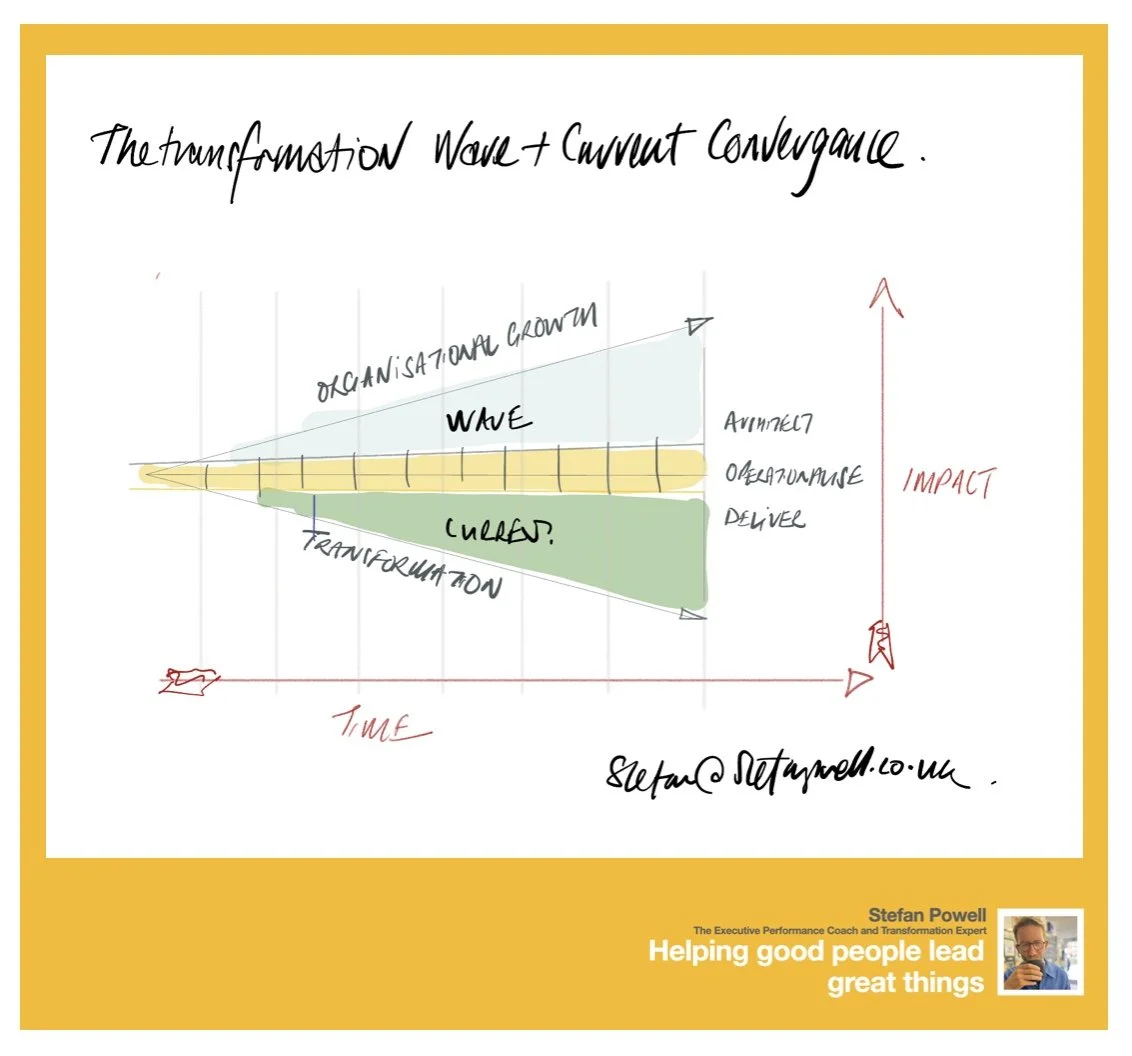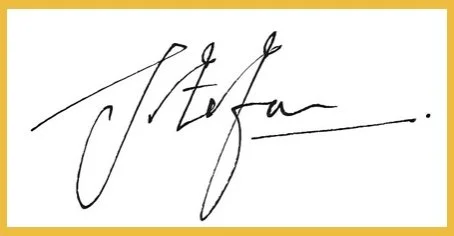Walking Out of a Coaching Session: The Wave - Current Convergence
Another in the series of post coaching session reflections; I know it will be useful to share with transformation leaders.
I just walked out of a coaching session with a senior leader in the transformation space - one of those conversations that leaves you reflecting on the real human juggle behind transformation. You know the kind: delivering organisational growth today while simultaneously transforming the systems, processes, and ways of working that will enable growth tomorrow. It’s the tension almost every transformation leader knows, and it’s exactly what we explored in our session.
I had drawn a simple visual to capture the challenge of transformation, and in the session, the leader brought their detail and nuance to it. Their perspective added richness to the story of how the Wave and the Current intersect in practice, highlighting real-world tensions, priorities, and opportunities.
Wave Above the Surface: Organisational Growth
The first element of the model is the Wave —-the growth that happens above the surface. This is the work everyone sees: delivering against KPIs, OKR’s, meeting customer expectations, hitting revenue or operational targets. It’s tangible, measurable, and often urgent. Boards, stakeholders, DGs, CEOs, MDs - everyone focused on organisational performance - naturally want to see short-term wins. They worry if things appear to pause or slow down.
And for good reason: organisations survive and thrive because of the visible performance that the Wave represents. But focusing on the Wave alone isn’t enough. Organisations that deliver short-term results without transforming their underlying systems risk stagnation. That’s where the Current comes in.
Current Beneath the Surface: Transformation
The Current is the undercurrent beneath the surface: systems, processes, culture, and organisational design. This is where the heavy lifting of transformation happens. It’s what enables long-term growth but is often less visible, harder to measure, and more complex to manage.
In our session, we talked about how leaders must simultaneously make waves while nurturing currents: delivering visible, short-term impact to satisfy stakeholders, while steadily building the operational and organisational foundations that will allow future transformation to succeed.
This is where concepts from systems thinking and organisational ambidexterity come alive. Peter Senge’s work reminds us that organisational structures shape behaviours, and small changes in underlying systems can have significant, often non-linear impacts on outcomes. O’Reilly and Tushman describe ambidexterity as the ability to exploit existing capabilities while simultaneously exploring new possibilities — a perfect description of what happens at the intersection of Wave and Current.
Convergence: Where Growth and Transformation Meet
The space between the Wave and the Current is the Convergence. This is where leaders operate every day, making pragmatic decisions about sequencing, pacing, and impact. It’s where the three fronts of transformation - architecting, operationalising, and delivering - collide with the immediate needs of organisational growth.
Architecting Transformation: defining the future state, the blueprint for what success looks like.
Operationalising Transformation: aligning people, processes, and resources so the transformation can actually move.
Delivering Transformation: executing, embedding, iterating, and measuring outcomes.
It’s a lot to hold in your head at once. And the Convergence is where leaders are tested - the space where adaptive leadership (Heifetz) meets the realities of organisational capacity and change saturation (Bridges, Prosci). Sometimes the ideal sequence of transformation steps has to give way to a pragmatic sequence dictated by what the organisation must deliver now.
The Science and Psychology Behind the Model
This simple visual draws on decades of research and practical insight. It reflects:
Dual Operating Systems (Kotter): organisations must run their performance system and transformation system in parallel.
Systems Thinking (Senge, Meadows): deeper structures produce behaviours, and understanding leverage points is key to effective transformation.
Adaptive Leadership (Heifetz): transformation requires managing both the technical and adaptive challenges — the visible and invisible work.
Behaviour Change (Fogg, Lewin, COM-B): lasting transformation happens when capability, opportunity, and motivation are aligned.
Temporal Alignment (Kahneman, behavioural economics): leaders must balance short-term pressures with long-term strategic change.
All of these principles reinforce the point we surfaced in our session: transformation isn’t just about a plan, a process, or a project. It’s about holding complexity, recognising tension, and guiding both the Wave and the Current toward impact.
Impact as the Anchor
At the heart of the Convergence is impact. The question isn’t just “what are we transforming?” but:
What impact do we want to have?
How do we measure it?
What impact are we currently having?
How well is the transformation working?
This focus on impact turns the model from a conceptual exercise into a practical leadership tool. It enables transformation leaders to illustrate and express the size of the task, break it down into its component elements, and have clear conversations about the magnitude and timeframe of the impact - recognising that impact can grow, evolve, and unfold in multiple dimensions.
Applying the Model in Practice
Once you can see the Wave - Current Convergence, it opens up practical ways to navigate transformation. For example, I often work with leaders to map out the phases of a whole year’s worth of change, particularly the first year, aligning what must be delivered with what must be transformed. The model makes these discussions tangible: you can visualise priorities, sequence actions, and understand the dependencies between short-term growth and long-term transformation.
It’s also an invaluable tool for conversations with stakeholders, team members, and wider organisational networks, both internally and externally. By illustrating the size and complexity of the task, leaders can give themselves - and others - permission to play different roles within the change: ideally as an architect shaping the vision and scope, sometimes operationalising to support execution, and very rarely focusing primarily on delivery.
This is where the metaphor of making waves while nurturing currents becomes powerful: visible short-term wins reassure stakeholders and sustain momentum, while the underlying currents steadily strengthen the organisation’s capacity for change. Managing this tension is central to successful transformation leadership.
A Reflective Insight
What I love about this model is that it started as a visual I had drawn - a way to make sense of the dual pressures leaders face - and in our session, the leader brought their detail and nuance to it. It’s practical, human-centred, and alive. Leaders don’t have to choose between growth and transformation. They have to understand the relationship between them and operate consciously in the Convergence.
Think of it as a lens for clarity, a guide for prioritisation, and a way to see where your attention, influence, and energy can have the greatest impact. If you’re leading change, transformation, or growth in your organisation, I hope this model gives you a way to hold the complexity, communicate the scale, and align your energy and that of your teams.
And if you’d like to explore how to map a year of transformation using this model, drop me a note - I’d be happy to have a conversation.
Enjoyed reading this? Consider doing one of these:
Get in touch - If any of this topic resonated with you and you have something you’d like to share with me or if you’d like to discuss working with me on this topic - stefan@stefanpowell.co.uk works really well for me.
Book an inquisitive session with me to find out more about what I do and how I do it or run a challenge or thought you have passed me.
Connect with me on linked in and read my long form posts on the rotating topics of Work, Rest. Play, Sustenance and Love every Thursday
Sign up to my newsletter ‘Be The Waves” here - which collates each weeks long form post on a monthly basis and you’ll get to read it later in the month
Follow me on strava.
For now; thank you
I am…
An executive coach and the CEO of Be The Waves, growing stewardship for a thriving planet.
I helping good people lead great things; in other words - I empower Stewardship
Good people care about others, our planet and beauty. Great things are changes for the betterment of society and all that lives within an around it. It sounds big and fun - it is.
I'm also an endurance racing cyclist and a go getter.
You can read more about me and what I do; how I work here

